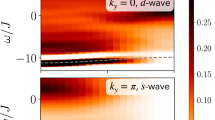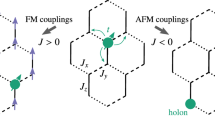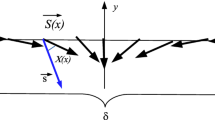Abstract
Doping an antiferromagnetic (AFM) Mott insulator is central to our understanding of a variety of phenomena in strongly correlated electrons, including high-temperature superconductors1,2. To describe the competition between tunnelling t of hole dopants and AFM spin interactions J, theoretical and numerical studies often focus on the paradigmatic t–J model3 and the direct analogue quantum simulation of this model in the relevant regime of high-particle density has long been sought4,5. Here we realize a doped quantum antiferromagnet with next-nearest-neighbour (NNN) tunnellings t′ (refs. 6,7,8,9,10) and hard-core bosonic holes11 using a Rydberg tweezer platform. We use coherent dynamics between three Rydberg levels, encoding spins and holes12, to implement a tunable bosonic t–J–V model allowing us to study previously inaccessible parameter regimes. We observe dynamical phase separation between hole and spin domains for |t/J| ≪ 1 and demonstrate the formation of repulsively bound hole pairs in a variety of spin backgrounds. The interference between NNN tunnellings t′ and perturbative pair tunnelling gives rise to light and heavy pairs depending on the sign of t. Using the single-site control allows us to study the dynamics of a single hole in 2D square lattice (anti)ferromagnets. The model we implement extends the toolbox of Rydberg tweezer experiments beyond spin-1/2 models13 to a larger class of t–J and spin-1 models14,15.
This is a preview of subscription content, access via your institution
Access options
Access Nature and 54 other Nature Portfolio journals
Get Nature+, our best-value online-access subscription
$32.99 / 30 days
cancel any time
Subscribe to this journal
Receive 51 print issues and online access
$199.00 per year
only $3.90 per issue
Buy this article
- Purchase on SpringerLink
- Instant access to full article PDF
Prices may be subject to local taxes which are calculated during checkout





Similar content being viewed by others
Data availability
All data are available from the corresponding author on request.
References
Lee, P. A., Nagaosa, N. & Wen, X.-G. Doping a Mott insulator: physics of high-temperature superconductivity. Rev. Mod. Phys. 78, 17–85 (2006).
Bohrdt, A., Homeier, L., Reinmoser, C., Demler, E. & Grusdt, F. Exploration of doped quantum magnets with ultracold atoms. Ann. Phys. 435, 168651 (2021).
Auerbach, A. Interacting Electrons and Quantum Magnetism (Springer, 1994).
Carroll, A. N. et al. Observation of generalized t-J spin dynamics with tunable dipolar interactions. Science 388, 381–386 (2025).
Gorshkov, A. V. et al. Tunable superfluidity and quantum magnetism with ultracold polar molecules. Phys. Rev. Lett. 107, 115301 (2011).
Qin, M. et al. Absence of superconductivity in the pure two-dimensional Hubbard model. Phys. Rev. X 10, 031016 (2020).
Jiang, H.-C. & Devereaux, T. P. Superconductivity in the doped Hubbard model and its interplay with next-nearest hopping t′. Science 365, 1424–1428 (2019).
Jiang, Y.-F., Devereaux, T. P. & Jiang, H.-C. Ground-state phase diagram and superconductivity of the doped Hubbard model on six-leg square cylinders. Phys. Rev. B 109, 085121 (2024).
Xu, H. et al. Coexistence of superconductivity with partially filled stripes in the Hubbard model. Science 384, eadh7691 (2024).
Bespalova, T. A., Delić, K., Pupillo, G., Tacchino, F. & Tavernelli, I. Simulating the Fermi-Hubbard model with long-range hopping on a quantum computer. Phys. Rev. A 111, 052619 (2025).
Bohrdt, A. et al. Microscopy of bosonic charge carriers in staggered magnetic fields. Preprint at https://arxiv.org/abs/2410.19500 (2024).
Homeier, L. et al. Antiferromagnetic bosonic t–J models and their quantum simulation in tweezer arrays. Phys. Rev. Lett. 132, 230401 (2024).
Browaeys, A. & Lahaye, T. Many-body physics with individually controlled Rydberg atoms. Nat. Phys. 16, 132–142 (2020).
Mögerle, J. et al. Spin-1 haldane phase in a chain of Rydberg atoms. PRX Quantum 6, 020332 (2025).
Liu, V. S. et al. Supersolidity and simplex phases in spin-1 Rydberg atom arrays. Preprint at https://arxiv.org/abs/2407.17554 (2024).
Scalapino, D. J. A common thread: the pairing interaction for unconventional superconductors. Rev. Mod. Phys. 84, 1383–1417 (2012).
Proust, C. & Taillefer, L. The remarkable underlying ground states of cuprate superconductors. Annu. Rev. Condens. Matter Phys. 10, 409–429 (2019).
Bednorz, J. G. & Müller, K. A. Possible highTc superconductivity in the Ba–La–Cu–O system. Z. Phys. B Condensed Matter 64, 189–193 (1986).
Keimer, B., Kivelson, S. A., Norman, M. R., Uchida, S. & Zaanen, J. From quantum matter to high-temperature superconductivity in copper oxides. Nature 518, 179–186 (2015).
Bloch, I., Dalibard, J. & Zwerger, W. Many-body physics with ultracold gases. Rev. Mod. Phys. 80, 885–964 (2008).
Mazurenko, A. et al. A cold-atom Fermi–Hubbard antiferromagnet. Nature 545, 462–466 (2017).
Shao, H.-J. et al. Antiferromagnetic phase transition in a 3D fermionic Hubbard model. Nature 632, 267–272 (2024).
Hirthe, S. et al. Magnetically mediated hole pairing in fermionic ladders of ultracold atoms. Nature 613, 463–467 (2023).
Lebrat, M. et al. Observation of Nagaoka polarons in a Fermi–Hubbard quantum simulator. Nature 629, 317–322 (2024).
Prichard, M. L. et al. Directly imaging spin polarons in a kinetically frustrated Hubbard system. Nature 629, 323–328 (2024).
Duan, L.-M., Demler, E. & Lukin, M. D. Controlling spin exchange interactions of ultracold atoms in optical lattices. Phys. Rev. Lett. 91, 090402 (2003).
Gross, C. & Bloch, I. Quantum simulations with ultracold atoms in optical lattices. Science 357, 995–1001 (2017).
Emery, V. J., Kivelson, S. A. & Lin, H. Q. Phase separation in the t-J model. Phys. Rev. Lett. 64, 475 (1990).
Boninsegni, M. Phase separation in mixtures of hard core bosons. Phys. Rev. Lett. 87, 087201 (2001).
Sun, H. et al. Realization of a bosonic antiferromagnet. Nat. Phys. 17, 990–994 (2021).
Jepsen, P. N. et al. Transverse spin dynamics in the anisotropic Heisenberg model realized with ultracold atoms. Phys. Rev. X 11, 041054 (2021).
Harris, T. J., Schollwöck, U., Bohrdt, A. & Grusdt, F. Kinetic magnetism and stripe order in the doped AFM bosonic t–J model. Preprint at https://arxiv.org/abs/2410.00904v1 (2024).
Zhang, H.-K., Zhang, J.-X., Xu, J.-S. & Weng, Z.-Y. Quantum-interference-induced pairing in antiferromagnetic bosonic t-J model. Preprint at https://arxiv.org/abs/2409.15424 (2024).
Siller, T., Troyer, M., Rice, T. M. & White, S. R. Bosonic model of hole pairs. Phys. Rev. B 63, 195106 (2001).
O’Mahony, S. M. et al. On the electron pairing mechanism of copper-oxide high temperature superconductivity. Proc. Natl. Acad. Sci. 119, e2207449119 (2022).
Morera, I., Bohrdt, A., Ho, W. W. & Demler, E. Attraction from kinetic frustration in ladder systems. Phys. Rev. Res. 6, 023196 (2024).
Sous, J. & Pretko, M. Fractons from polarons. Phys. Rev. B 102, 214437 (2020).
Barredo, D. et al. Coherent excitation transfer in a spin chain of three Rydberg atoms. Phys. Rev. Lett. 114, 113002 (2015).
Emperauger, G. et al. Benchmarking direct and indirect dipolar spin-exchange interactions between two Rydberg atoms. Phys. Rev. A 111, 062806 (2025).
Wadenpfuhl, K. & Adams, C. S. Unravelling the structures in the van der Waals interactions of alkali Rydberg atoms. Phys. Rev. A 111, 062803 (2025).
Winkler, K. et al. Repulsively bound atom pairs in an optical lattice. Nature 441, 853–856 (2006).
Staszewski, L. & Wietek, A. Quench dynamics of stripes and phase separation in the two-dimensional t-J model. Phys. Rev. B 112, 035125 (2025).
White, S. R. & Scalapino, D. J. Phase separation and stripe formation in the two-dimensional t–J model: a comparison of numerical results. Phys. Rev. B 61, 6320 (2000).
Kagan, M. Y., Kugel, K. I. & Rakhmanov, A. L. Electronic phase separation: recent progress in the old problem. Phys. Rep. 916, 1–105 (2021).
Ji, G. et al. Coupling a mobile hole to an antiferromagnetic spin background: transient dynamics of a magnetic polaron. Phys. Rev. X 11, 021022 (2021).
Chen, C. et al. Continuous symmetry breaking in a two-dimensional Rydberg array. Nature 616, 691–695 (2023).
Weber, S. et al. Tutorial: Calculation of Rydberg interaction potentials. J. Phys. B: At. Mol. Opt. Phys. 50, 133001 (2017).
Marder, M., Papanicolaou, N. & Psaltakis, G. C. Phase separation in a t-J model. Phys. Rev. B 41, 6920 (1990).
Bobroff, J. et al. Absence of static phase separation in the high Tc cuprate YBa2Cu3O6+y. Phys. Rev. Lett. 89, 157002 (2002).
Daley, A. J. Quantum trajectories and open many-body quantum systems. Adv. Phys. 63, 77–149 (2014).
Hauschild, J. et al. Tensor network Python. Code available at https://github.com/tenpy/tenpy/. Documentation available at https://tenpy.readthedocs.io/en/latest/ (2018).
Hauschild, J. & Pollmann, F. Efficient numerical simulations with Tensor Networks: Tensor Network Python (TeNPy). SciPost Phys. Lect. Notes https://doi.org/10.21468/scipostphyslectnotes.5 (2018).
Acknowledgements
We thank J. Mögerle, K. Brechtelsbauer and H.-P. Büchler for insightful discussions about encoding spins using three Rydberg states and J. Mögerle for help on the use of the pairinteraction software package47. This work is supported by the Agence Nationale de la Recherche (ANR-22-PETQ-0004 France 2030, project QuBitAF), the European Research Council (Advanced Grant no. 101018511-ATARAXIA) and the Horizon Europe programme HORIZON-CL4-2022-QUANTUM-02-SGA (project 101113690 (PASQuanS2.1). R.M. acknowledges support by the ‘Fondation CFM pour la Recherche’ through a Jean-Pierre Aguilar PhD scholarship. L.H. is supported by the Simons Collaboration on Ultra-Quantum Matter, which is a grant from the Simons Foundation (651440). L.H. and F.G. were supported by the Deutsche Forschungsgemeinschaft (DFG, German Research Foundation) under Germany’s Excellence Strategy - EXC-2111 - 390814868 and have received funding from the European Research Council (ERC) under the European Union’s Horizon 2020 research and innovation programme (grant agreement no. 948141) – ERC Starting Grant SimUcQuam. S.H. acknowledges support through the Harvard Quantum Initiative Postdoctoral Fellowship in Quantum Science and Engineering. S.G. acknowledges support by Structures (DFG) under Germany’s Excellence Strategy EXC2181/1-390900948). D.B. acknowledges support from MCIN/AEI/10.13039/501100011033 (PID2020-119667GA-I00, CNS2022-135781, EUR2022-134067 and European Union NextGenerationEU PRTR-C17.I1).
Author information
Authors and Affiliations
Contributions
M.Q., G.E., C.C., G.B. and R.M. carried out the experiments, with the help of B.G., L.K. and D.B. L.H. and M.Q. conducted the numerical simulations. L.H., S.H., S.G. and N.-C.C. devised the Rydberg scheme combining dipolar and van der Waals couplings to realize the t–J model. A. Bohrdt, F.G., T.L. and A. Browaeys supervised the work. All authors contributed to the data analysis, progression of the project and on both the experimental and theoretical sides. All authors contributed to the writing of the manuscript. Correspondence and requests for materials should be addressed to Antoine Browaeys or Mu Qiao.
Corresponding authors
Ethics declarations
Competing interests
A. Browaeys and T.L. are cofounders and shareholders of PASQAL. The other authors declare no competing interests.
Peer review
Peer review information
Nature thanks Xiong-Jun Liu, Ivan Morera Navarro and the other, anonymous, reviewer(s) for their contribution to the peer review of this work.
Additional information
Publisher’s note Springer Nature remains neutral with regard to jurisdictional claims in published maps and institutional affiliations.
Extended data figures and tables
Extended Data Fig. 1 Protocol for the preparation of a doped antiferromagnet along z.
a, Involved energy levels and transitions. The states used in the mapping to the t–J–V Hamiltonian are indicated in black. Each of the three columns represents one class of atoms: non-addressed atoms (left column) are prepared in |↓⟩, atoms with both δ↓ and δ↑ light shifts (centre column) are prepared in |h⟩ and atoms with only the δ↑ light shift (right column) are prepared in |↑⟩. b, Experimental sequence. After Rydberg excitation using STIRAP, we apply a sequence of microwave pulses combined with the site-resolved light shifts δ↑ and δ↓. Then, the light shifts are switched off for duration T, during which the system evolves under the t–J–V interactions. To read out the atomic states, we first perform two ‘freezing’ pulses to stop the dynamics, which respectively act on states |h⟩ and |↑⟩. Then, we deexcite the atoms from |↓⟩ to the ground-state manifold, switch on the tweezers and image the recaptured atoms using fluorescence. An extra microwave π-pulse (dotted green line) can be used to read out the state |h⟩.
Extended Data Fig. 2 Simplified error tree associated to our detection schemes.
The three panels a, b and c show the detection errors for the populations in, respectively, |g⟩, |↓⟩ and |h⟩. For each scheme, we represent the probability of detection events for the four states |g⟩, |↓⟩, |h⟩ and |↑⟩, at the first order in the detection errors ε, \({\varepsilon }_{S,P}^{{\prime} }\) and ηMW.
Extended Data Fig. 3 State-preparation errors for 1D chain.
Site-resolved population measurements for different initial state preparations at various angles θ relative to the quantization axis, showing the initial state-preparation error. The detection error is corrected through the maximal likelihood method, using the cost function of equation (4). a–c, Population distributions for an initial Néel state with four holes in the centre at θ = 30° (a), θ = 45° (b) and θ = 54° (c). d–f, population distributions for different numbers of holes at θ = 51.7°: one hole (d), two holes (e) and four holes (f). g–j Population distributions for different magnetic backgrounds: AFM along z at θ = 49.7° (g) and θ = 59.7° (h) and AFM and FM along x (i,j). The measured populations are shown for the four possible states: ground state (black), |↓⟩ (red), |h⟩ (white) and |↑⟩ (blue). These errors are systematically included in all of the numerical simulations presented in the main text.
Extended Data Fig. 4 State-preparation errors for 2D array.
a, Population measurement for a FM state (red) with a single hole |h⟩ (white) at the centre. b, Population measurement for a Néel-ordered state alternating between |↑⟩ (blue) and |↓⟩ (red) with a central hole. The pie charts at each site show the relative populations of the four possible states: ground state (black), |↓⟩ (red), |h⟩ (white) and |↑⟩ (blue). Detection errors have been corrected using a maximum likelihood estimation method. The observed state-preparation fidelities are incorporated into the numerical simulations presented in the main text.
Extended Data Fig. 5 Angular dependence of interactions.
a, The van der Waals interaction coefficients \({C}_{6}^{\alpha \beta }({\theta }_{ij})\) are calculated from the Rydberg pair interactions at a magnetic field magnitude of B = 50 G for various angles θij between the inter-atomic axis and the magnetic field (solid markers). We fit the each coefficient to the function \({f}^{\alpha \beta }({\theta }_{ij})={F}_{1}^{\alpha \beta }+{F}_{2}^{\alpha \beta }{\cos }^{2}{\theta }_{ij}+{F}_{3}^{\alpha \beta }{\cos }^{4}{\theta }_{ij}\) (solid line). b, The coupling amplitudes of the t–J–V–W model are computed using Extended Data Table 1. The spin–hole interaction W/J⊥ ≈ 0 for all angles and hence we can neglect it for all practical purposes in our interpretation of the experimental results. Note that numerical calculations are based on the full Rydberg Hamiltonian.
Extended Data Fig. 6 Boundary terms.
Site-dependent field terms \({h}_{j}^{z}\) and μj calculated as in Fig. 5. a, Fields at angle θ = 90° for the 12-site chain realized in the experiment. As the difference in magnitude between the fields at the boundary compared with the bulk is large, those terms can play a role in the presence of boundaries. b, To quantify the boundary terms, we plot the difference of the fields between sites 2 and 1 as a function of the angle θ.
Extended Data Fig. 7 Interference from NNN tunnellings t′.
We numerically study the time evolution of an initial hole pair in the L = 12 z-AFM without errors under: (1) the full Rydberg Hamiltonian and (2) a model with interactions truncated beyond the NN couplings. The angles are chosen to be θ = 49.7° (t < 0) and θ = 59.7° (t > 0) (see Fig. 3). a, We plot the centre-of-mass pair displacement of the pair. The solid line corresponds to model (1) and corresponds to an ideal experiment without errors; the difference in the centre-of-mass pair displacement is clearly visible, which we explain by the interference between perturbative and NNN tunnelling t′. When we consider the model with only NN couplings (2), shown as dashed lines, the strong difference in the pair displacement disappears. b, We compare the pair distance histograms at time \(T=1.6\times \frac{2{\rm{\pi }}}{| 2t| }\) and find that the hole is more tightly bound for θ = 49.7° than for θ = 59.7°, independent of the range of tunnellings. This is consistent with our perturbative description of the pair, for which the binding energy only depends on the hole–hole repulsion V and spin interaction Jz.
Rights and permissions
Springer Nature or its licensor (e.g. a society or other partner) holds exclusive rights to this article under a publishing agreement with the author(s) or other rightsholder(s); author self-archiving of the accepted manuscript version of this article is solely governed by the terms of such publishing agreement and applicable law.
About this article
Cite this article
Qiao, M., Emperauger, G., Chen, C. et al. Realization of a doped quantum antiferromagnet in a Rydberg tweezer array. Nature 644, 889–895 (2025). https://doi.org/10.1038/s41586-025-09377-1
Received:
Accepted:
Published:
Issue date:
DOI: https://doi.org/10.1038/s41586-025-09377-1



